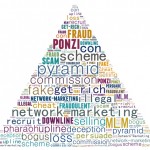
Debt sucks. Via Shutterstock.
Carrying credit card debt is a real drag. When you’ve got high-interest bills hanging over your head, saving toward long-term goals, such as buying a home or starting a family, becomes much more difficult. Rather than bide your time by paying the minimum each month…
Commit to knocking down your debt with these 6 simple tips.
1. Determine Your Total Debt
Before you start paying off debt, you need to know exactly where you stand. Total up all of your credit card debts, add in your student loans, and any money you owe your friends or family. Even if the total is scary, there’s no need to feel overwhelmed. This is your starting point – there’s nowhere to go but up.
2. Use a Budgeting Website
Rather than using Microsoft Excel or writing out a budget by hand, do yours online to simplify the process. There are several free budgeting websites to choose from. Mint is one of the more popular options, but BudgetPulse and You Need a Budget also work well. Input all your monthly bills and expenses, and don’t forget annual expenses, such as car insurance.
Once your income and expenses are inputted, your goal is to reduce your monthly expenses to create a surplus in your budget. This surplus can be directed toward your outstanding debts.
3. Reduce Spending
Reduce your spending in every area possible. Cut back or completely eliminate discretionary spending on things like clothing, electronics, and entertainment. Even if it’s hard right now, think about the extra cash you’ll free up when your debts are paid off.
4. Pick a Pay Down Strategy
If you have many small debts, consider using the debt snowball strategy. This strategy involves paying off your smallest debts first. It’s also a great strategy if you want to reduce the total number of bills you have to pay each month. For instance, if you have 10 debts, most of them under $1,000, you might want to choose a small store credit card debt of $200 to pay off first. Then you can mark that one off your list, and move on to the next small debt.
If you’re a more disciplined individual, choose the debt avalanche strategy. This involves paying down the debts with the highest interest rate first, saving you more money in the long run because you’re not continuing to accumulate high levels of interest. For instance, if you owe $1,500 on a Best Buy credit card at 27% interest, and $1,200 on a standard credit card at 11% interest, you’ll save more over time by paying off the Best Buy card first due to its high interest rate.
5. Set Goals and Track Your Progress
Set realistic goals for yourself to pay down your debt, and keep an eye on your progress. If you come up short, don’t give up. Reduce your spending further and do your best to get back on track. Remember – the simple fact that you’re finally addressing your debt situation is an excellent step in the right direction.
6. Reward Yourself
When you reach a goal or cross a major bill off your list, reward yourself. Take in a movie or schedule a get together with friends. By celebrating the little wins, you’ll stay motivated to keep working toward the final outcome.
When I was much younger, I never paid much attention to my personal and credit card debt, until it got so out of hand that I found myself close to $30,000 in the hole. Although it took a good bit of work, once I got on track, I just stayedd the course until I was debt-free. Whether your debts are minor, or though the roof, it is possible to eliminate them once and for all. And when you do, you’ll be stunned at how much more you have in your checking account at the end of each month.
What’s your perspective on carrying credit card debt?
This post is by contributor James Clark, who uses his own experiences of getting out of debt to share tips and thoughts related to saving money, managing a budget, and building long-term wealth.








You didn’t mention generating income to pay off the debt.
Sell things that you are not longer using like exercise equipment that you bought with a good intention but rarely if ever used. Have a garage sale. This is a good time to get rid of clutter and turn it into cash to further reduce your debt.
Dear Guest: Why are you not identified with a byline? If I have to identify myself for a comment, why don’t I know who you are who is dispensing information on an important topic?
Hi Diane! The writer James Clark is actually identified in the bottom of the post. You can also find a short bio there. James is labeled as a guest writer because he isn’t a regular weekly writer for Bargain Babe. Does this answer your question?
Thanks, Dacia. I tend to skim when a topic doesn’t grab me, but I now have seen the “blurb” on him because you pointed out where it was. And, of course, I didn’t know there were different byline policies for regular contributors and guests.
The one thing that was left out is to stop using your cards. If you must make a purchase that would affect your payment plan, pay cash. Accept a minor setback but stay the course for the long run.
First of all, never pay interest. Make payments in full each month, then the problem never arises. If you have got into debt, pay off highest interest debts first. Do without, cut back, use a little discipline. Try and remember that credit cards are for your convenience, and not for you to help the banks/credit card companies make a profit. When you go into debt make sure it is for something big and necessary – a car or a house for instance.